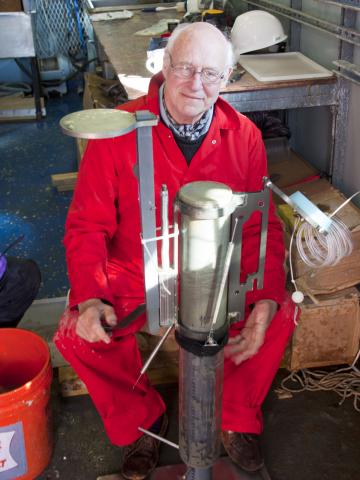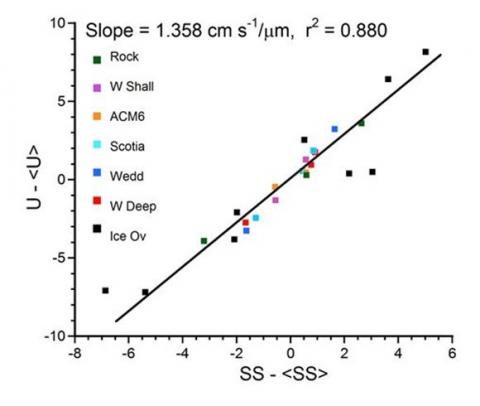Research
The Sediment Record of the Deep-Sea Circulation

Slicing multicore at 0.5 cm intervals (<10 years per slice) south of Iceland May 2014, RV Endevour.
My research aims to understand how the modern deep ocean circulation shapes the sea bed and controls the distribution of sediment types, grain-sizes and bedforms. I then apply that understanding to interpretation of the geological record of the changing deep-sea circulation in piston and gravity cores for the late Pleistocene, and Ocean Drilling Project cores for the Neogene and earlier Pleistocene. Insight developed over the last 30 years concerning mechanics of fine sediment erosion, transport, aggregation and deposition shows that sediments become more cohesive, and all form aggregates, below 10 µm grainsize, but above that size they increasingly behave non-cohesively and are sorted by prevailing currents. This 'sortable silt' (10-63 µm) has a mean size that provides a proxy for depositional current speed and allows insight into changes in deep circulation vigour.
The deeper objective is to understand the impact of climate change on the deep sea (and vice versa). Part of the meridional heat flux on earth is carried by warm surface ocean currents with a corresponding cold deep return flow. We look for good monitoring points for these deep flows and have studied the inflow to the North Atlantic south of Iceland, and the deep inflows to the Pacific east of New Zealand and Indian ocean east of Madagascar. Among our recent striking results are the discovery of a Holocene ~1500 year variability in the flow south of Iceland, matching the Mediaeval Warm Period - Little Ice Age climate changes, flow changes at the inception of the Antarctic circum-polar current, and Southern Ocean control of flow in the glacial deep N. Atlantic.
Current work is focussed on records of relatively shallow flows in the sub-Arctic around Greenland and Iceland as well as the Southern Ocean. Here the problem of disentangling the effects of sediment delivery by ice rafting and current-controlled transport and deposition has been a necessary precursor to examination of late Glacial and Holocene sediment data revealing Atlanti and Pacific (Bering throughflow) influences on the E. Greenland and Labrador Currents.
Cartoon of two settings for deposition of ice-rafted and plume-delivered sediment from McCave & Andrews (2019a): A) Sediment falls out from icbergs into a fast current, fines are removed to downstream locations where they are deposited at a place where the current is slower, forming a drift, while coarse material (medium sand to gravel) falls directly to the bed at the point of release where it remains. B) Sediment falls out into a slow current and all material falls directly to the bed close to the point of release. Fauna show the bi-polar nature of the processes.

Normalised sortable silt mean size versus normalised mean flow speed U; Sensitivity is 1.36 ± 0.19 cm s-1/μm which allows us to specify the magnitude of flow speed changes on climatic transitions from millions to a few tens of years ago.
Publications
ORCID link: https://orcid.org/0000-0002-4702-5489

